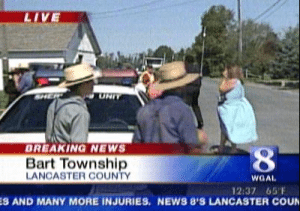 Some news stories have lasting psychological effects on journalists. Just ask anyone who covered the 9/11 attacks or the aftermath of Hurricane Katrina. But traumatic effects like stress disorders aren’t confined to major national disasters, as the staff of WGAL-TV learned in October 2006 when a gunman killed five little girls and injured five at a rural Amish schoolhouse. Assignment manager Adrienne Garvey says the crime shocked the quiet community of Lancaster, Pa., and affected everyone involved.
Some news stories have lasting psychological effects on journalists. Just ask anyone who covered the 9/11 attacks or the aftermath of Hurricane Katrina. But traumatic effects like stress disorders aren’t confined to major national disasters, as the staff of WGAL-TV learned in October 2006 when a gunman killed five little girls and injured five at a rural Amish schoolhouse. Assignment manager Adrienne Garvey says the crime shocked the quiet community of Lancaster, Pa., and affected everyone involved.
For the dozens of first responders, it would be a trying day. Before the week was over, they would have debriefing sessions and would receive counseling. But for the journalists covering the story, some of them arriving on scene just minutes after the first emergency workers, help would not come for weeks. They would have to deal with the raw emotion and haunting images on their own.
Garvey studied the impact of the incident on her newsroom colleagues and wrote about it in her 2009 masters thesis. Her conclusion:
Managers in broadcast television news stations need to be more aware of the impact of stories on the lives of their employees. While some offer counseling after the coverage of a traumatic story, there are still too many broadcast television news employees whose suffering goes unnoticed and untreated.
WGAL is owned by Hearst-Argyle, which had a toll-free phone
number employees could call for counseling assistance, but none of the employees Garvey surveyed said they took advantage of it in the wake of the school shootings.
About two weeks after the shootings, the station brought in a corporate manager to lead a debriefing session. Most of the employees surveyed felt it came too late or was so ineffective they don’t even remember hearing about or attending the session.
One photographer told Garvey, “I had put it behind me only to dredge it up again. I understand the reason to learn about coverage for the future but felt a little violated by the questions (from the person from corporate). I felt like a lab rat forced into sharing with someone who was not part of the coverage and she had no business being there.”
A reporter saw it differently. “It was helpful to simply talk about the emotions involved in covering the story with colleagues. It was also reassuring to hear that colleagues clearly felt similar emotions.”
WGAL’s news director, Dan O’Donnell, told Garvey there is no way to really prepare a newsroom for the effect of a traumatic news story. But managers clearly need to know what those effects may be, including insomnia and emotional numbness, nightmares, headaches, anxiety, and a quicker temper than usual. Many of those symptoms were manifest in WGAL employees after the shootings, Garvey says.
O’Donnell says that if he had to do it over, he might bring professional counselors into the newsroom for anyone who needed to talk. But Garvey doubts that would make a difference. “Journalists are typically guarded people when their emotions are involved,” she says. “They don’t want anyone to see them as weak or they may not be assigned to the big story next time.” Nevertheless, she believes that trained observers in the newsroom could point out to managers which employees may be struggling. And she urges managers to hold a formal debriefing session within days of a crisis, not weeks.
Garvey’s study is one of the few I’ve seen that looks at how an entire TV newsroom was affected by a traumatic local incident and its coverage. And as a former newscast producer, she makes a particularly valuable point about producers.
Producers may not be on the actual crime scenes, but they are expected to find stories for their newscasts and that often involves going through stories that are happening across the country. Many of those stories are violent and have details producers would never dream of actually broadcasting, yet producers are expected to read those details and screen video to make sure it is appropriate for air. It’s arguable that producers may actually be exposed to even more trauma than [some] reporter/photographer teams.
One could also argue that the same goes for video editors. So it’s key that whatever support a newsroom provides in connection with a traumatic story be made available to all staff, not just those traditionally considered to be on the front lines.









3 Comments
Within a few hours of the 9/11 attacks, I was assigned the job of screening and archiving every single bit of footage that came through the feeds. I was to make the decision if the footage was bad enough to withhold from air. There clearly was some that was not airable. I did that job for a solid week, so I was exposed to nearly all of the aftermath…in the privacy of my edit bay. There were a few nightmares and a un-natural obsession with the news coverage of the attacks..but I never felt I needed counciling or the use of a shrink. I think a lot of it is how you handle the situation and respond to it. If you lose your head everytime something goes wrong in life, a story like this will make it all the worse. Being a pragmatist, I try to roll with the punches and not run around yelling “The sky is falling!”.
VERY GOOD JOB. THIS IS SOMETHING THAT THOSE OF US IN POLICE AND FIRE AND EMS GO THRU EVERYDAY. IT HELPS TO TALK WITH SOMEONE, EVEN A CO-WORKER THAT IS FEELING THE SAME THING TO HELP GET THRU. AGAIN A VERY GOOD JOB.